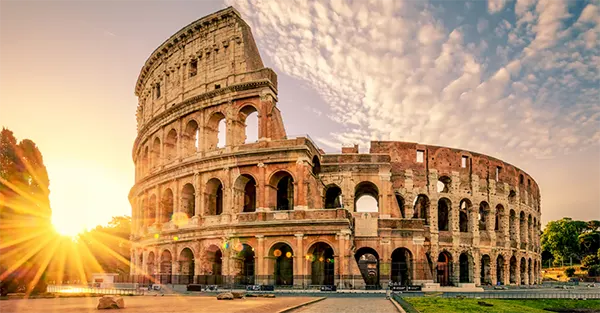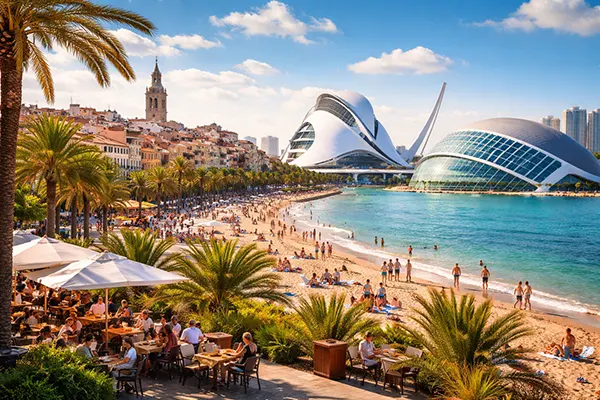
The Colosseum in Rome – More Than a Gladiator Arena
The Colosseum, also known as the Flavian Amphitheatre, is one of the most recognisable landmarks in the world. While many associate it primarily with gladiatorial combat, its role in Roman society and history was much broader. As of 2025, the Colosseum continues to serve as a cultural symbol, a tourist destination, and an object of preservation that connects modern generations with the legacy of the Roman Empire.
The Historical Importance of the Colosseum
The Colosseum was commissioned by Emperor Vespasian in AD 72 and completed under his son Titus in AD 80. Constructed from concrete and stone, it became the largest amphitheatre of its time, capable of hosting over 50,000 spectators. It was not only a place of entertainment but also a political instrument, symbolising the power and authority of the emperors.
Beyond gladiatorial fights, the Colosseum staged public spectacles including animal hunts, naval battles, and executions. These events reinforced imperial propaganda, demonstrating Rome’s wealth and military dominance. The amphitheatre was also used for celebrations, reinforcing its role as a unifying space for Roman citizens.
Over the centuries, the Colosseum suffered damage from earthquakes, neglect, and stone looting. Despite this, large parts of its structure remain intact, allowing historians and visitors alike to imagine its grandeur during the height of the Roman Empire.
Architectural and Engineering Marvel
The Colosseum’s architecture demonstrates the advanced engineering skills of the Romans. Its elliptical design ensured that spectators had clear views of the arena from every angle. The hypogeum, a network of underground tunnels and chambers, allowed organisers to manage complex performances, from lifting wild animals to coordinating gladiators’ entrances.
Innovative use of arches and vaults distributed weight effectively, enabling the amphitheatre to stand the test of time. The structure also incorporated awnings, known as the velarium, to provide shade for spectators. Such details reveal the sophistication of Roman urban planning and public infrastructure.
Modern archaeological studies continue to uncover new insights into how the Colosseum operated, reaffirming its role as a masterpiece of ancient engineering.
The Colosseum in Modern Culture
Today, the Colosseum is more than a historical ruin; it is a global cultural symbol. In 1980, it was added to the UNESCO World Heritage list, and in 2007, it was named one of the New Seven Wonders of the World. Each year, millions of visitors explore its monumental remains, making it one of the most visited attractions in Italy.
The Colosseum also serves as a venue for cultural events, exhibitions, and ceremonies. The Vatican, for example, has used the site for the annual Good Friday “Way of the Cross” procession led by the Pope. These modern uses demonstrate how the amphitheatre continues to be a space of gathering and reflection.
Beyond tourism, the Colosseum has become a symbol in campaigns against capital punishment, with authorities lighting up the monument whenever a death sentence is commuted or abolished anywhere in the world. This contemporary role adds a layer of moral significance to the ancient structure.
Preservation and Challenges
Preserving the Colosseum remains a significant challenge due to environmental pollution, weathering, and the sheer age of the monument. Italian authorities, together with international organisations, have invested heavily in conservation efforts. Restoration projects have included cleaning stonework, reinforcing walls, and improving accessibility for visitors.
In recent years, technological solutions such as 3D scanning and digital modelling have been used to monitor structural health. These innovations provide new opportunities to protect the Colosseum for future generations while ensuring accuracy in historical reconstructions.
Despite these efforts, challenges persist, especially due to climate change and increasing tourist numbers. Sustainable tourism practices and international cooperation are crucial to maintaining the integrity of this world heritage site.

The Colosseum’s Lasting Legacy
The influence of the Colosseum extends far beyond Rome. Its design has inspired modern stadiums around the world, from Europe to the Americas. The concept of large-scale entertainment venues with tiered seating can be traced directly to this ancient amphitheatre.
Artists, writers, and filmmakers continue to draw inspiration from the Colosseum. It has appeared in countless works of literature, paintings, and films, solidifying its status as a symbol of human ambition, creativity, and resilience. The structure embodies both the grandeur and the brutality of Roman society.
As a monument that has survived for nearly two millennia, the Colosseum stands as a reminder of the continuity between past and present. Its legacy is not just in stone, but in the way it shapes cultural memory and global identity.
A Monument for Future Generations
Looking ahead, the Colosseum will remain a cornerstone of historical education and cultural tourism. Its preservation ensures that future generations will be able to witness and learn from the architectural achievements of the ancient world.
Ongoing research projects continue to reveal details about Roman life, engineering techniques, and social structures. These discoveries deepen our understanding of how the Colosseum functioned within the broader context of the empire.
Ultimately, the Colosseum is more than an ancient ruin—it is a living monument that bridges the gap between antiquity and the modern world, offering insights into human history while continuing to inspire admiration and respect.




